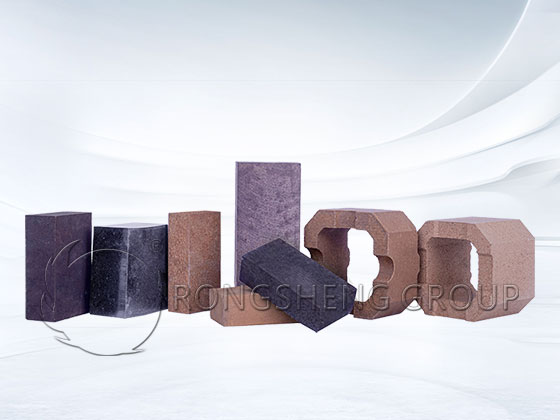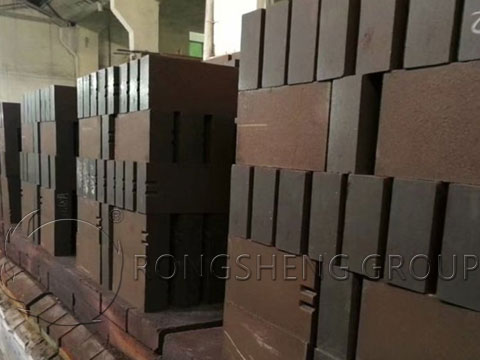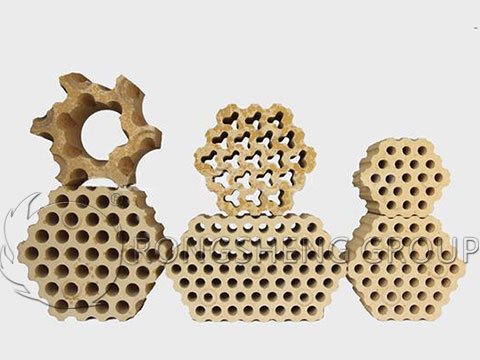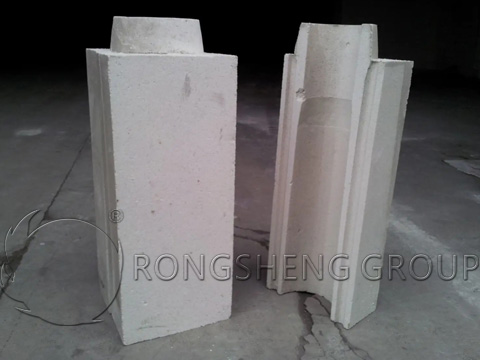The Magnesium Oxide Content of Alkaline Refractory Bricks
Alkaline refractory bricks are a kind of refractory material mainly composed of magnesia raw materials. They have excellent slag erosion resistance, thermal shock resistance and high temperature structural stability. In industries such as metallurgy, building materials, and chemicals, alkaline refractory bricks are widely used in the lining of high-temperature equipment such as furnaces, cement rotary kilns, and glass kilns. Rongsheng Refractory Materials Manufacturer has summarized a variety of commonly used alkaline refractory bricks based on years of production and sales experience. So, do you know the magnesium oxide content of alkaline refractory bricks?

Various Alkaline Refractory Bricks
- Magnesia-Chrome Brick: Magnesia-Chrome Brick is an alkaline refractory brick made of magnesia and chromite as the main raw materials and sintered at high temperatures. Magnesia chrome bricks have the advantages of high melting point, high strength, and high resistance to slag erosion. Suitable for working conditions under high temperature, high pressure, and strong alkali environment.
- Magnesia-alumina brick: Magnesia-alumina brick is an alkaline refractory brick made of magnesia and alumina as the main raw materials, adding an appropriate amount of additives, and sintering at high temperature. Magnesia-alumina bricks have good thermal shock resistance, slag erosion resistance, and high-temperature structural stability. Suitable for lining of high-temperature equipment such as cement rotary kilns and glass kilns.
- Magnesia-calcium brick: Magnesia-calcium brick is an alkaline refractory brick made of magnesia and lime as the main raw materials, adding an appropriate amount of additives, and sintered at high temperature. Magnesia-calcium bricks have high thermal shock resistance and slag erosion resistance. Suitable for high-temperature equipment in steel, nonferrous metals and other industries.
- Magnesia dolomite brick: Magnesia dolomite brick is an alkaline refractory brick made of magnesia and dolomite as the main raw materials, adding an appropriate amount of additives, and sintering at high temperature. Magnesium dolomite bricks have good thermal shock resistance, slag erosion resistance, and high-temperature structural stability. Suitable for lining of high-temperature equipment such as cement rotary kilns and glass kilns.

Magnesium Content of Alkaline Refractory Bricks
- Magnesia chrome bricks: The magnesium content of magnesia chrome bricks is generally between 60% and 80%, and the chromium content is between 20% and 40%. The magnesium content of magnesia-chrome bricks is high, which is beneficial to improving its resistance to slag erosion and high-temperature structural stability.
- Magnesia-alumina bricks: The magnesium content of magnesia-alumina bricks is generally between 50% and 70%, and the aluminum content is between 20% and 40%. The magnesium content of magnesia-alumina bricks is moderate, which is beneficial to improving its thermal shock resistance and slag erosion resistance.
- Magnesia-calcium bricks: The magnesium content of magnesia-calcium bricks is generally between 50% and 70%, and the calcium content is between 20% and 40%. The magnesium content of magnesia-calcium bricks is moderate, which is beneficial to improving its thermal shock resistance and slag erosion resistance.
- Magnesium dolomite bricks: The magnesium content of magnesia dolomite bricks is generally between 50% and 70%, and the dolomite content is between 20% and 40%. The magnesium content of magnesia dolomite bricks is moderate, which is beneficial to improving its thermal shock resistance and slag erosion resistance.
Precautions
When selecting alkaline refractory bricks, the appropriate type and magnesium content should be selected based on specific working conditions and requirements.
When laying alkaline refractory bricks, attention should be paid to controlling the size of the brick joints, generally between 2-3mm. Excessive brick joints will lead to increased heat loss, while brick joints that are too small are not conducive to the expansion and contraction of the brick body.
During the masonry process, special anchors should be used to fix the refractory bricks on the base body to prevent the bricks from loosening and falling off. The selection and installation of anchors should comply with design requirements and construction specifications.
After the masonry is completed, the bricks should be trimmed and excess mortar should be removed to make the brick surface smooth and beautiful.
In short, alkaline refractory brick is a refractory material with excellent properties and is widely used in high-temperature equipment in metallurgy, building materials, chemical industry and other industries. When selecting and using alkaline refractory bricks, the appropriate type and magnesium content should be selected according to the specific working conditions and requirements to ensure the safe and stable operation of the equipment.

Magnesite Checker Bricks for Glass Kiln
In the refractory industry, refractory bricks with MgO as the main component and periclase as the main crystal phase are collectively called alkaline refractory bricks. Alkaline refractory bricks are mainly used in thermal kilns used in cement, glass, ferroalloy and other industries.
In glass-melting furnaces, alkaline refractory bricks are mainly used as regenerator checker bricks. Its thermal conductivity is large, its service life is long, and its volume density is high, which increases the heat storage in the regenerator. The porosity of alkaline refractory bricks is low, and the thermal expansion coefficient increases linearly as the temperature rises. It is the largest among various refractory materials. Pay attention to leaving enough expansion joints during use.
Alkaline refractory bricks are non-insulators above 900°C and have very good electrical conductivity and cannot be used as high-temperature insulating materials.
Alkaline refractory bricks cannot be used in gas regenerators. And long-term contact with water vapor at 40~160℃ will cause hydration, which will cause the brick structure to become loose and damaged. So keep it dry during storage. Before laying the magnesite checkered bricks, the regenerator must be dried.
At present, including ordinary magnesia bricks, magnesia refractory materials also have the following types.
- Ordinary magnesia bricks. It is made of sintered magnesite as raw material and sintered. The content of MgO is about 91%. It is a magnesium refractory product directly combined with silicate and is widely produced and used.
- Directly bonded magnesia bricks. It is made of high-purity sintered magnesia as raw material and sintered. The content of MgO is more than 95%. It is a magnesia refractory product directly bonded between periclase grains.
- Magnesia silica brick. It is made of high-silicon sintered magnesite as raw material and sintered. SiO2 content is 5%~11%, it is a magnesia refractory product combined with forsterite.
- Forsterite Bricks. Forsterite refractory material is a refractory material with forsterite as the main crystal phase. It is mostly made of peridotite and pure peridotite as the main raw materials, and the formed products are called forsterite bricks.
Buy high-quality alkaline refractory bricks, magnesia bricks, magnesia checker bricks for glass kilns, metallurgical kilns, etc. Please choose Rongsheng refractory material manufacturer. Rongsheng manufacturer, product quality is reliable and delivery speed is guaranteed. Moreover, comprehensive customer service effectively guarantees the service life of the refractory furnace lining and saves production costs for customers.
